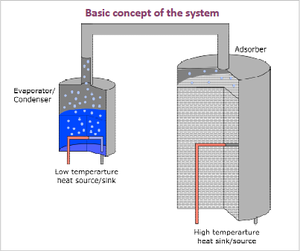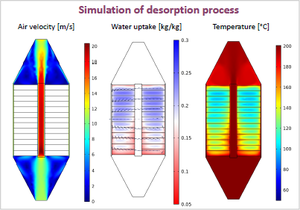WP3-1 Numerical and experimental investigations of the adsorption processes in a closed sorption system
Numerical investigation on closed adsorption systems
Hosted by: | SWT Stuttgart |
|---|---|
Student: | Simone Semprini |
Started: | 01/02/2016 |
Supervisor(s): | Henner Kerskes |
Short description
When designing closed adsorption systems, two points are crucial. On the one hand side, temperature regulation and heat transfer out of the reactor demand a suitable heat exchanger design. The heat conductivity of most adsorption materials is lower than 1 W/(m*K), therefore in most applications heat transfer has to be increased by metal baffles and fins. On the other hand, providing enough steam requires a low temperature heat source and a high efficient evaporator. This low temperature heat source has to provide an adequate heat stream with a temperature higher than the saturation temperature inside the evaporator.
Therefore, the design of a closed adsorption storage requires a careful optimization of heat transfer inside the reactor. This optimization process can be improved with a powerful and efficient simulation tool to get a better understanding of the parameters such as pressure, temperature and current uptake inside the reactor during charging and discharging. Developing such a model is the main aim of this PhD project. It should be detailed enough to describe the basic processes during adsorption and desorption and calculate the key parameters within a small error range. On the other hand, it must not be too complex so that the numerical effort is limited.


In recent years, the research in the area of heat storage is leading towards more innovative technologies in order to increase storage density and decrease losses. One of the technologies investigated is adsorption heat storage in closed systems. These systems promise about six times higher energy densities than conventional water tanks with almost zero long-term energy losses.
Adsorption describes an equilibrium reaction between a gaseous phase and a solid material. The solid material, also called sorbent, adsorbs vapour on the surface and in its pores. The vapour pressure around the sorbent and the sorbents temperature define the amount of adsorbed vapour under stationary conditions, called equilibrium uptake. Closed sorption systems always consist of two components, the reactor, that carries the sorbent, and the evaporator/condenser unit, that contains the liquid phase of the vapour. During adsorption or discharging, the liquid phase evaporates and then adsorbs on the sorbent in the reactor. In that course the so-called heat of adsorption is released. This heat is the useful energy in heat storage applications. The process can also be reversed for desorption or charging respectively. Closed sorption systems can also serve as cold storages. In those applications, the useful energy is not the heat output of the reactor but the heat put into the evaporator for evaporation.
The project is divided in two main core tasks:
- Development of an experimental set-up to test the system and determine the effective performance. The experimental set-up is a “classic” closed adsorption system, containing an adsorption reactor, an evaporator/condenser unit and the piping between them. The temperature and pressure inside the reactor and temperature and pressure in the evaporator are measured. Unfortunately, it is still not possible to measure the water uptake online. However, detailed data on the temperature profile and pressure are sufficient to determine performance of the system. In addition, the experimental set-up is used for the validation of the simulation model.
- the second task of the project are numerical simulations with validation of results through experimental procedures. Therefore, a powerful CFD software is necessary to carry out the simulations. COMSOL™ offers a good balance between usability and numerical efficiency and it will be used for the simulation of the adsorption process.
Numerical tools:
- COMSOL
- MATLAB
Currently, the test rig has been correctly installed and the first experiments are being performed. Currently, a COMSOL model is already been developed but not validated yet. The next step will be to compare the results of the model with the experimental data obtained from the tests.
